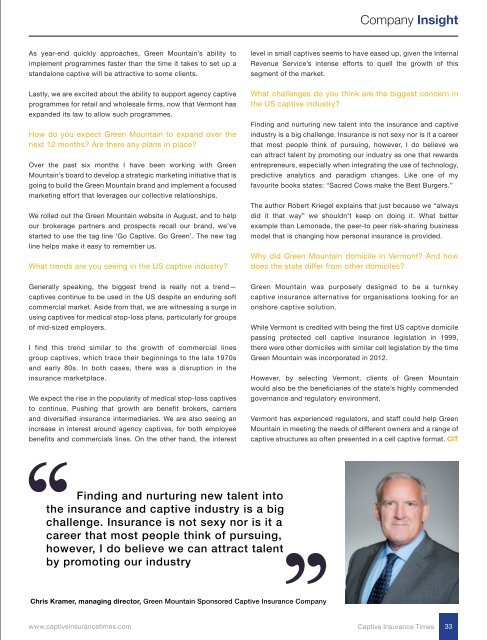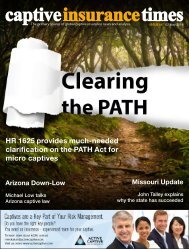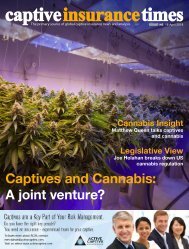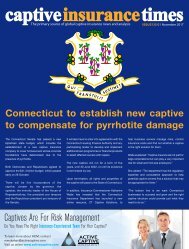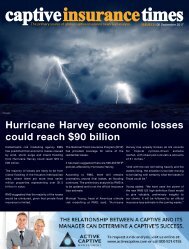Captive Insurance Times issue 136
Inside this issue of Captive Insurance Times, find out what industry experts predict the potential opportunities and challenges will be for the captive industry in 2018. Phillip Giles of QBE North America provides his thoughts on future opportunities for the healthcare sector. Also, history shows that it is difficult to predict when interest rates will change and when markets will rise or fall, which, according to Stephen Nedwicki of Comerica Bank, is even more reason to maintain a disciplined approach to your investments.
Inside this issue of Captive Insurance Times, find out what industry experts predict the potential opportunities and challenges will be for the captive industry in 2018.
Phillip Giles of QBE North America provides his thoughts on future opportunities for the healthcare sector.
Also, history shows that it is difficult to predict when interest rates will change and when markets will rise or fall, which, according to Stephen Nedwicki of Comerica Bank, is even more reason to maintain a disciplined approach to your investments.
You also want an ePaper? Increase the reach of your titles
YUMPU automatically turns print PDFs into web optimized ePapers that Google loves.
Company Insight<br />
As year-end quickly approaches, Green Mountain’s ability to<br />
implement programmes faster than the time it takes to set up a<br />
standalone captive will be attractive to some clients.<br />
level in small captives seems to have eased up, given the Internal<br />
Revenue Service’s intense efforts to quell the growth of this<br />
segment of the market.<br />
Lastly, we are excited about the ability to support agency captive<br />
programmes for retail and wholesale firms, now that Vermont has<br />
expanded its law to allow such programmes.<br />
How do you expect Green Mountain to expand over the<br />
next 12 months? Are there any plans in place?<br />
Over the past six months I have been working with Green<br />
Mountain’s board to develop a strategic marketing initiative that is<br />
going to build the Green Mountain brand and implement a focused<br />
marketing effort that leverages our collective relationships.<br />
We rolled out the Green Mountain website in August, and to help<br />
our brokerage partners and prospects recall our brand, we’ve<br />
started to use the tag line ‘Go <strong>Captive</strong>. Go Green’. The new tag<br />
line helps make it easy to remember us.<br />
What trends are you seeing in the US captive industry?<br />
What challenges do you think are the biggest concern in<br />
the US captive industry?<br />
Finding and nurturing new talent into the insurance and captive<br />
industry is a big challenge. <strong>Insurance</strong> is not sexy nor is it a career<br />
that most people think of pursuing, however, I do believe we<br />
can attract talent by promoting our industry as one that rewards<br />
entrepreneurs, especially when integrating the use of technology,<br />
predictive analytics and paradigm changes. Like one of my<br />
favourite books states: “Sacred Cows make the Best Burgers.”<br />
The author Robert Kriegel explains that just because we “always<br />
did it that way” we shouldn’t keep on doing it. What better<br />
example than Lemonade, the peer-to peer risk-sharing business<br />
model that is changing how personal insurance is provided.<br />
Why did Green Mountain domicile in Vermont? And how<br />
does the state differ from other domiciles?<br />
Generally speaking, the biggest trend is really not a trend—<br />
captives continue to be used in the US despite an enduring soft<br />
commercial market. Aside from that, we are witnessing a surge in<br />
using captives for medical stop-loss plans, particularly for groups<br />
of mid-sized employers.<br />
I find this trend similar to the growth of commercial lines<br />
group captives, which trace their beginnings to the late 1970s<br />
and early 80s. In both cases, there was a disruption in the<br />
insurance marketplace.<br />
We expect the rise in the popularity of medical stop-loss captives<br />
to continue. Pushing that growth are benefit brokers, carriers<br />
and diversified insurance intermediaries. We are also seeing an<br />
increase in interest around agency captives, for both employee<br />
benefits and commercials lines. On the other hand, the interest<br />
Green Mountain was purposely designed to be a turnkey<br />
captive insurance alternative for organisations looking for an<br />
onshore captive solution.<br />
While Vermont is credited with being the first US captive domicile<br />
passing protected cell captive insurance legislation in 1999,<br />
there were other domiciles with similar cell legislation by the time<br />
Green Mountain was incorporated in 2012.<br />
However, by selecting Vermont, clients of Green Mountain<br />
would also be the beneficiaries of the state’s highly commended<br />
governance and regulatory environment.<br />
Vermont has experienced regulators, and staff could help Green<br />
Mountain in meeting the needs of different owners and a range of<br />
captive structures so often presented in a cell captive format. CIT<br />
Finding and nurturing new talent into<br />
the insurance and captive industry is a big<br />
challenge. <strong>Insurance</strong> is not sexy nor is it a<br />
career that most people think of pursuing,<br />
however, I do believe we can attract talent<br />
by promoting our industry<br />
Chris Kramer, managing director, Green Mountain Sponsored <strong>Captive</strong> <strong>Insurance</strong> Company<br />
www.captiveinsurancetimes.com<br />
<strong>Captive</strong> <strong>Insurance</strong> <strong>Times</strong><br />
33


